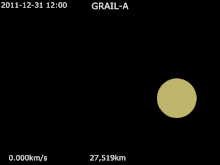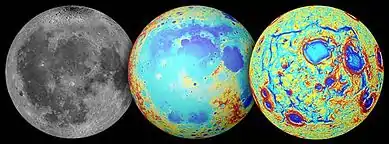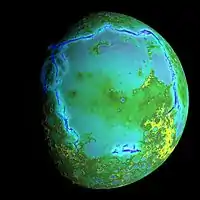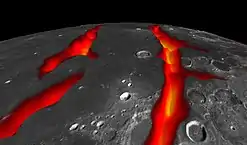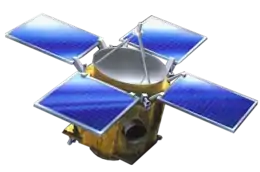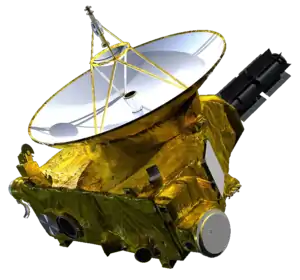GRAIL
The Gravity Recovery and Interior Laboratory (GRAIL) was an American lunar science mission in NASA's Discovery Program which used high-quality gravitational field mapping of the Moon to determine its interior structure. The two small spacecraft GRAIL A (Ebb) and GRAIL B (Flow)[3][4] were launched on 10 September 2011 aboard a single launch vehicle: the most-powerful configuration of a Delta II, the 7920H-10.[1][5][6] GRAIL A separated from the rocket about nine minutes after launch, GRAIL B followed about eight minutes later. They arrived at their orbits around the Moon 25 hours apart.[7][8] The first probe entered orbit on 31 December 2011 and the second followed on 1 January 2012.[9] The two spacecraft impacted the Lunar surface on December 17, 2012.[10]
 Artist's interpretation of the GRAIL tandem spacecraft above the lunar surface. | |
| Operator | NASA / JPL[1][2] |
|---|---|
| COSPAR ID | 2011-046 (A, B) |
| SATCAT no. | 37801, 37802 |
| Website | moon |
| Mission duration | 1 year, 3 months, 7 days, 9 hours |
| Spacecraft properties | |
| Manufacturer | Massachusetts Institute of Technology, LMSS |
| Launch mass | 307 kg (677 lb) |
| Dry mass | 132.6 kg (292 lb) |
| Power | (Solar array / Li-ion battery) |
| Start of mission | |
| Launch date | September 10, 2011, 13:08:52.775 UTC |
| Rocket | Delta II 7920H-10 D-356 |
| Launch site | Cape Canaveral SLC-17B |
| Entered service | December 31, 2011 (Ebb) January 1, 2012 (Flow) |
| Orbital parameters | |
| Reference system | Selenocentric |
| Regime | Polar orbit |
| Semi-major axis | 1,788.0 kilometres (1,111.0 mi) |
| Periselene altitude | 25 kilometres (16 mi) |
| Aposelene altitude | 86 kilometres (53 mi) |
| Period | 113 minutes |
| Lunar impactor | |
| Impact date | GRAIL A: December 17, 2012, 22:28:51 UTC |
| Impact site | 75.6083°N 33.4043°E |
| Lunar impactor | |
| Impact date | GRAIL B: December 17, 2012, 22:29:21 UTC |
| Impact site | 75.6504°N 33.1643°E |

| |
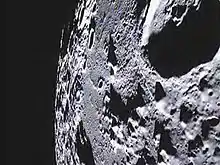
Overview

Maria Zuber of the Massachusetts Institute of Technology is GRAIL's principal investigator. NASA's Jet Propulsion Laboratory manages the project. As of August 5, 2011, the program had cost US$496 million.[11] Upon launch the spacecraft were named GRAIL A and GRAIL B and a contest was opened to school children to select names. Nearly 900 classrooms from 45 states, Puerto Rico and the District of Columbia, participated in the contest. The winning names, Ebb and Flow, were suggested by 4th grade students at Emily Dickinson Elementary School in Bozeman, Montana.[4]
Each spacecraft transmitted and received telemetry from the other spacecraft and Earth-based facilities. By measuring the change in distance between the two spacecraft, the gravity field and geological structure of the Moon was obtained. The two spacecraft were able to detect very small changes in the distance between one another. Changes in distance as small as one micrometre were detectable and measurable.[12][13] The gravitational field of the Moon was mapped in unprecedented detail.[14][15]
Objectives
- Map the structure of the lunar crust and lithosphere
- Understand the asymmetric thermal evolution of the Moon
- Determine the subsurface structure of impact basins and the origin of lunar mascons
- Ascertain the temporal evolution of crustal brecciation and magmatism
- Constrain the deep interior structure of the Moon
- Place limits on the size of the Moon's inner core
The data collection phase of the mission lasted from 7 March 2012 to 29 May 2012, for a total of 88 days. A second phase, at a lower altitude, of data collection began 31 August 2012,[16] and was followed by 12 months of data analysis.[14] On 5 December 2012 NASA released a gravity map of the Moon made from GRAIL data.[17] The knowledge acquired will aid understanding of the evolutionary history of the terrestrial planets and computations of lunar orbits.[18]
Spacecraft
Instruments
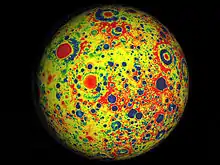
- Ka band Lunar Gravity Ranging System (LGRS), derived from the Gravity Recovery and Climate Experiment (GRACE) instrument.[19] 90% of the GRACE software was reused for GRAIL.[20]
- Radio science beacon (RSB)
- Moon Knowledge Acquired by Middle school students (MoonKAM).[21] Each MoonKAM system (one per spacecraft) consists of a digital video controller and four camera heads.[22] Click here for a MoonKAM photo from lunar orbit.
Propulsion
Thrusters aboard each spacecraft were capable of producing 22 newtons (4.9 lbf).[19] Each spacecraft was fueled with 103.5 kilograms (228 lb) of hydrazine to be used by the thrusters and main engine to enable the spacecraft to enter lunar orbit and transition to the science phase of its mission. The propulsion subsystem consisted of a main fuel tank and a Re-repressurization system which were activated shortly after lunar orbit insertion.[23]
Mission profile
Launch attempts
| Attempt | Planned | Result | Turnaround | Reason | Decision point | Weather go (%) | Notes |
|---|---|---|---|---|---|---|---|
| 1 | 8 Sep 2011, 8:37:06 am | scrubbed[24] | — | high level winds | 8 Sep 2011, 8:30 am | 40% | A weather balloon was released minutes before the decision point to take the latest readings of upper level winds and Air Force weather reconnaissance aircraft were aloft beginning at 7 am. |
| 2 | 8 Sep 2011, 9:16:12 am | scrubbed[24] | 0 days, 0 hours, 39 minutes | high level winds | 8 Sep 2011, 9:07 am | 40% [25] | Range was reconfigured for omni antennae instead of tracked ones to support 99 degree azimuth. |
| 3 | 9 Sep 2011, 8:33:25 am | abandoned[24] | 0 days, 23 hours, 17 minutes | rocket propulsion | 40% | An issue with the rocket's propulsion system was detected while the Delta 2 rocket was drained of fuel. | |
| 4 | 10 Sep 2011, 8:29:45 am | scrubbed[24] | 0 days, 23 hours, 56 minutes | high level winds | 10 Sep 2011, 8:21 am | 60% | |
| 5 | 10 Sep 2011, 9:08:52 am | Success[24] | 0 days, 0 hours, 39 minutes |
 Spacecraft technicians close the payload fairing around GRAIL before launch.
Spacecraft technicians close the payload fairing around GRAIL before launch. GRAIL awaits launch at Cape Canaveral Air Force Station.
GRAIL awaits launch at Cape Canaveral Air Force Station. Fire and smoke light up a blue sky as a United Launch Alliance Delta II Heavy rocket propels GRAIL into space.
Fire and smoke light up a blue sky as a United Launch Alliance Delta II Heavy rocket propels GRAIL into space.
Transit phase
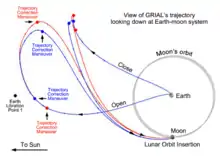
Unlike the Apollo program missions, which took three days to reach the Moon, GRAIL made use of a three- to four-month low-energy trans-lunar cruise well outside the Moon's orbit and passing near the Sun-Earth Lagrange point L1 before looping back to rendezvous with the Moon. This extended and circuitous trajectory enabled the mission to reduce fuel requirements, protect instruments and reduce the velocity of the two spacecraft at lunar arrival to help achieve the extremely low 50 km (31 mi) orbits with separation between the spacecraft (arriving 25 hours apart) of 175 to 225 km (109 to 140 mi).[18][26] The very tight tolerances in the flight plan left little room for error correction leading to a launch window lasting one second and providing only two launch opportunities per day.[25]
Science phase
The primary science phase of GRAIL lasted for 88 days, from 7 March 2012 to 29 May 2012. It was followed by a second science phase starting on 8 Aug.
The gravity mapping technique was similar to that used by Gravity Recovery and Climate Experiment (GRACE), and the spacecraft design was based on XSS-11.[27]
The orbital insertion dates were December 31, 2011 (for GRAIL-A) and January 1, 2012 (for GRAIL-B).[24]
The spacecraft were operated over the 88-day acquisition phase, divided into three 27.3 day long nadir-pointed mapping cycles. Twice each day there was an 8-hour pass in view of the Deep Space Network for transmission of science and "E/PO MoonKam" data.[28]
Terminal phase

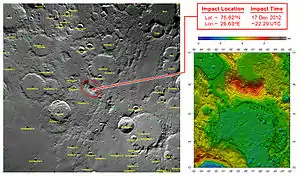
Final experiment and mission end
At the end of the science phase and a mission extension, the spacecraft were powered down and decommissioned over a five-day period. The spacecraft impacted the lunar surface on December 17, 2012.[28][29][30][31][32][33] Both spacecraft impacted an unnamed lunar mountain between Philolaus and Mouchez at 75.62°N 26.63°W. Ebb, the lead spacecraft in formation, impacted first. Flow impacted moments later. Each spacecraft was traveling at 3,760 miles per hour (1.68 km/s). A final experiment was conducted during the final days of the mission. Main engines aboard the spacecraft were fired, depleting remaining fuel. Data from that effort will be used by mission planners to validate fuel consumption computer models to improve predictions of fuel needs for future missions.[34] NASA has announced that the crash site will be named after GRAIL collaborator and first American woman in space, Sally Ride.[35]
References
- "Delta II Set to Launch NASA's GRAIL Mission". United Launch Alliance. 2011. Archived from the original on 1 September 2011. Retrieved 2 September 2011.
- "The GRAIL Mission: A Fact Sheet". Sally Ride Science. 2010. Archived from the original on 2010-04-28. Retrieved 2010-04-15.
- Schontzler, Gail. "Bozeman class wins contest to name satellites orbiting moon". Bozeman Daily Chronicle. Retrieved 2018-12-18.
- Agle, DC. "Montana Students Submit Winning Names for NASA Lunar Spacecraft". NASA JPL.
- "Delta II: The Industry Workhorse" (PDF). United Launch Alliance. 2010. Archived from the original (PDF) on 30 September 2011. Retrieved 2 August 2011. Cite journal requires
|journal=(help) - Grey Hautaluoma (10 December 2007). "New NASA Mission to Reveal Moon's Internal Structure and Evolution". NASA. Retrieved 31 August 2011.
- Moon-bound twin GRAIL spacecraft launch success
- Spaceflight101 Archived 2015-02-11 at the Wayback Machine
- "First of NASA's GRAIL Spacecraft Enters Moon Orbit". NASA. Retrieved 1 January 2012.
- GRAIL Twins crash into the Moon to complete highly successful Mission Archived 2015-02-11 at the Wayback Machine
- Marcia Dunn, AP Aerospace Writer (5 August 2011). "NASA Spacecraft Begins 5-Year Trip to Jupiter". Yahoo News. Retrieved 7 September 2011.
- GRAVITY RECOVERY AND INTERIOR LABORATORY (GRAIL) MISSION: STATUS AT THE INITIATION OF THE SCIENCE MAPPING PHASE, 43rd Lunar and Planetary Science Conference (2012)
- Washington Post December 17, 2012
- "About GRAIL". Massachusetts Institute of Technology. Retrieved 2011-03-12.
- Lemoine, Frank G.; Goossens, Sander; Sabaka, Terence J.; Nicholas, Joseph B.; Mazarico, Erwan; Rowlands, David D.; Loomis, Bryant D.; Chinn, Douglas S.; Neumann, Gregory A.; Smith, David E.; Zuber, Maria T. (28 May 2014). "GRGM900C: A degree 900 lunar gravity model from GRAIL primary and extended mission data". Geophysical Research Letters. 41 (10): 3382–3389. doi:10.1002/2014GL060027. PMC 4459205.
- Gravity Recovery and Interior Laboratory: News & Features: NASA's GRAIL Moon Twins Begin Extended Mission Science Archived 2013-04-09 at the Wayback Machine. Solarsystem.nasa.gov. Retrieved on 2013-07-21.
- Gravity Recovery and Interior Laboratory: News & Features: NASA's GRAIL Creates Most Accurate Moon Gravity Map Archived 2013-05-11 at the Wayback Machine. Solarsystem.nasa.gov. Retrieved on 2013-07-21.
- "GRAIL: Mission Overview". MIT. Retrieved 10 September 2011.
- "Spacecraft and Payload". Massachusetts Institute of Technology.
- "GRAIL: Mission Operations & Data Processing". MIT. Archived from the original on 2012-03-05. Retrieved 2012-12-14.
- "About GRAIL MoonKAM". Sally Ride Science. 2010. Archived from the original on 2010-04-27. Retrieved 2010-04-15.
- "GRAIL Launch Press Kit" (PDF). NASA. Retrieved 31 August 2011.
- GRAIL (Gravity Recovery and Interior Laboratory)
- Harwood, William. "NASA launches GRAIL lunar probes". CBS News. Retrieved 11 September 2011.
- Justin Ray (17 August 2011). "GRAIL Launch Window Chart". SpaceFlight Now. Retrieved 9 September 2011.
- "Mission Design". NASA. Archived from the original on 3 October 2011. Retrieved 10 September 2011.
- Taylor Dinerman (31 December 2007). "Is XSS-11 the answer to America's quest for Operationally Responsive Space?". The Space Review. Retrieved 31 August 2011.
- "GRAIL: Mission Design". MIT.
- "NASA GRAIL Twins Complete Their Moon Impact". NASA. 17 December 2012. Retrieved 2012-12-17.
- Wall, Mike (13 December 2012). "Twin GRAIL probes readied for crash into Moon". NBC News. Retrieved 18 February 2013.
- Wall, Mike (11 December 2012). "Twin NASA Probes to Crash into Moon Next Week". Space.com. Retrieved 18 February 2013.
- "Twin NASA spacecraft prepare to crash into moon". Phys.org. 13 December 2012. Retrieved 13 December 2012.
- Knapp, Alex (14 December 2012). "NASA Prepares To Crash Its Probes Into The Moon". Forbes. Retrieved 2012-12-13.
- "NASA Probes Prepare for Mission-Ending Moon Impact". NASA, Jet Propulsion Laboratory. Retrieved 18 February 2013.
- Mike Wall (17 December 2012). "Moon Probes' Crash Site Named After Sally Ride". Space.com. Retrieved 18 February 2013.
External links
| Wikimedia Commons has media related to GRAIL. |
- GRAIL: Mission NASA
- NASA GRAIL (Gravity Recovery and Interior Laboratory) – mission home page
- MIT GRAIL Home Page
- NASA Science Missions: GRAIL (Gravity Recovery and Interior Laboratory)
- NASA 360 New Worlds New Discoveries 2/2 Retrieved 6/3/2011.
- Behind The Scenes of My NASA GRAIL Experience – Day One (AM)

